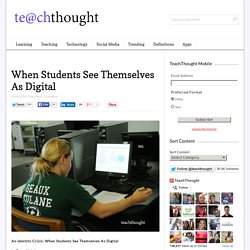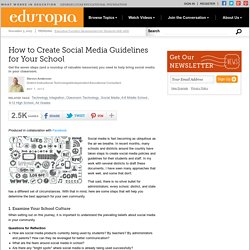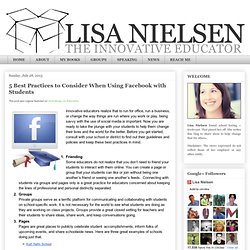

Stc_online_safety_quiz. Social Media for every Class and Subject (pt. 1 – Instagram!) – Teaching Without a Quill. Social Media can be SO scary, as kids are posting anything and everything now on the internet.

Whether it is scary or not, they LOVE it, so as teachers we need to start using what they love to get them hooked on learning. Mrs. Tyler’s Class Instagram Simple: Create a class Instagram. Tell your students your account information at the beginning of the year, and have them follow you. Why would you want a class Instagram? Reminding kids of BIG assignments due. I have over 50 students following me on my class Instagram. 2. 10 Cool Ways Teachers Use Social Media to Enhance Learning. Doing work that matters.

All students should be able to be part of that. No longer working for the teacher’s wastebasket, students across the world are connecting and sharing like never before. They are led by teachers unafraid of the world but who escort their kids out to meet the future. While a recent poll showed 9 out of 10 teachers do not use social media in the classroom, there are teachers who are. Social doesn’t have to be a distraction and kids can be safe. This question is part of CM Rubin World’s question of the month, “What are the best examples you have seen of teachers using social media to enhance learning?” 1. Aussie teacher Jacques du Toit has his students create Twitter accounts as many of the well known Aztecs. 2.
Social Media for every Class and Subject (pt. 1 – Instagram!) – Teaching Without a Quill. Christiansburg Police offering social media advice for parents. CHRISTIANSBURG, Va. - Following new details about 13-year old Nicole Lovell and the use of social media playing a role in her death, parents are asking for more information on protecting their children online.

Christiansburg Police offer classes whenever they are asked to, and they've seen a recent spike in requests. "It's unfortunate that it takes a tragedy to open the eyes of the parents and the children but hopefully for the future, it will prevent a lot of other tragedies,” Internet Crimes Against Children Investigator Maureen McClanahan said.
Crimes Against Children Research Center. CCRC currently conducting telephone interviews The Crimes against Children Research Center is currently conducting telephone interviews with adults across the country about their experiences being threatened and blackmailed online with sexual images.

Updated Trends in Child Maltreatment, 2013 New national data for 2013 show continued declines in child maltreatment, after a one year discontinuity (2012) in which some rates briefly increased. But from 2012 to 2013, sexual abuse declined 4%, physical abuse declined 3%, child maltreat-ment fatalities declined 7% and overall substantiated child mal-treatment declined 1%.
Expert Says Online Interactions Rarely Lead To Child Homicides. The recent kidnapping and death of 13-year-old Nicole Lovell, allegedly perpetrated by two Virginia Tech students she'd met through popular instant messaging app Kik, has incited a torrent of concern from parents, fearful their child will end up the next victim of tech-savvy predators.

But that worry is grossly misguided, according to David Finkelhor, director of the Crimes Against Children Research Center in Durham, New Hampshire. A University of New Hampshire sociology professor since 1978, Finkelhor tells PEOPLE research that dates back to the 1990s reveals "the abduction and murder of a child by someone they met online is an extremely rare kind of crime.
" "We have done a number of studies looking at cases of Internet crimes against children that are known to the police, and annually, the vast majority of homicides of children are at the hands of family members, peers, gang members, dating partners – people they know," says Finkelhor. • Want to keep up with the latest crime coverage? Expert Says Online Interactions Rarely Lead To Child Homicides. Teachers, Teens and Social Media: Q&A with Danah Boyd. Teens, Technology and Friendships. Video games, social media and mobile phones play an integral role in how teens meet and interact with friends This report explores the new contours of friendship in the digital age.

It covers the results of a national survey of teens ages 13 to 17; throughout the report, the word “teens” refers to those in that age bracket, unless otherwise specified. The survey was conducted online from Sept. 25 through Oct. 9, 2014, and Feb. 10 through March 16, 2015, and 16 online and in-person focus groups with teens were conducted in April 2014 and November 2014. For today’s teens, friendships can start digitally: 57% of teens have met a new friend online.
Teen Social Media Infographic from Common Sense Media. An Identity Crisis: When Students See Themselves As Digital. An Identity Crisis: When Students See Themselves As Digital by Terry Heick Students that have more control than ever over their own identity have, unsurprisingly, lost control of that identity.

Coldly, and as a matter of “settings,” they are able to dictate when, how, where, and by whom they are seen. Connectivity has closed the walls of the world around them–or at least made them transparent–until they have zero room to wiggle and squirm. Digital Natives, Yet Strangers to the Web. When Reuben Loewy took up his first teaching gig in 2012, he had a major revelation: The digital revolution has dramatically transformed the way that kids perceive reality.

Perhaps that makes the 55-year-old teacher sound like a dinosaur. What he discovered is, after all, one of the most obvious realities shaping education policy and parenting guides today. But, as Loewy will clarify, his revelation wasn’t simply that technology is overhauling America’s classrooms and redefining childhood and adolescence. How to Create Social Media Guidelines for Your School. Produced in collaboration with Facebook.

Social media is fast becoming as ubiquitous as the air we breathe. In recent months, many schools and districts around the country have taken steps to create social media policies and guidelines for their students and staff. In my work with several districts to draft these documents, I have seen many approaches that work well, and some that don't. That said, there is no silver bullet for administrators; every school, district, and state has a different set of circumstances.
Instagram, Vine, and Porn: What Parents Should Know. MakingProgress_Web%20-Final.pdf. 3 people & 3 ideas for using Twitter to share, discover, & connect with students. Safety first but don't forget what's next when students use social media. 5 Best Practices to Consider When Using Facebook with Students. This post was original featured on Smartblogs on Education Innovative educators realize that to run for office, run a business, or change the way things are run where you work or play, being savvy with the use of social media is important.

Now you are ready to take the plunge with your students to help them change their lives and the world for the better. Before you get started, consult with your school or district to find out their guidelines and policies and keep these best practices in mind.Friending Some educators do not realize that you don’t need to friend your students to interact with them online. You can create a page or group that your students can like or join without being one another’s friend or seeing one another’s feeds. Educators should consider having a strictly professional profile when communicating with students on Facebook.
5 Best Practices to Consider When Using Facebook with Students. 5 ideas to inspire students to use social media for good. How teachers use Pinterest in the classroom. Connected Learning. The headlines are legion, the sentiment, widespread: “Why Social Media is Destroying Our Social Skills” (USA Today). “Evidence Grows That Online Social Networks Have Insidious Negative Effects” (MIT Technology Review). The rise of social media, many fear, is ruining authentic interpersonal relationships. No amount of social media, we are repeatedly told, can ever equal face-to-face interaction. Social networking has altered our very vocabulary. And it’s not just a matter of “tweets.” Russ Warner: Top Ways Kids Hide Their Online Behavior From Parents.
Most parents believe they are in control when it comes to teaching a child about the use of digital devices. The reality is that children are learning at younger ages about technology, and they are largely unsupervised. A recent report said 47 percent of kids ages 8 to 12 years old have a smart phone with Internet access. Another study said kids use digital devices more than seven hours a day.
In short, kids are using digital devices with Internet access most of the time after school and when not sleeping. At the same time, most parents admit their child catches on quickly and seems to learn faster about technology than they did. What If Colleges Used Social Media Well? A savvy professor caught me in the hallway to discuss a presentation we had both seen on social media and its potential for local businesses.
She had a great question that really threw me: what if colleges actually used social media well? I like the question a lot. How to Use Social Media for Your Education. Photo credits: 1, 2 Let’s face it, most of us already spend hours on end clicking between the Twitter, Facebook, and Pinterest tabs on our web browsers. In this day and age, it seems like social media consumes our daily lives. Since we already dedicate so much attention to these sites, it’s high time that we make our surfing useful and productive. Controlling Social Media: Current Policy Trends in K-12 Education. Social Networking | Viewpoint Controlling Social Media: Current Policy Trends in K-12 Education As social media becomes ubiquitous, schools and districts should shift from trying to control its use and toward teaching faculty and students how to build successful learning communities.
As school boards address the overall challenge of social media use within schools, they should focus on the reality that the impact no longer lies only on the individual and local schools. Social networks include students and teachers all over the world and, therefore, teaching and coaching on digital literacy for teachers and students is where the focus should rest. Knowing how to build successful communities of learning and how to integrate social connectivity within a learning environment is a much more needed outcome than finding a way to control and monitor specific users and content.
Social media use may lead to poor grades. Many college students could not imagine a day without updating their Twitter feeds or Facebook statuses, but according to a recent study led by researchers at the Miriam Hospital, using social media may impair academic performance. The study was published online in the journal Emerging Adulthood last month. 100 Tips, Tools, and Resources for Teaching Students About Social Media - 2013's Top Teaching Degrees: Compare Programs by Cost, Location, Size.
By Tara Miller Some educators have expressed an appreciation for the irony of experienced instructors who have had to learn about social media later in their careers teaching it to younger students who have grown up in an Internet environment. The Internet and social networking - Learning and Teaching. The Internet is a rich resource for teaching and learning. Web 2.0 refers to a more recent 2nd generation collection of web-based tools, usually involving social networking (sites like facebook) and amateur publishing (like blogs and youTube). Below are resources which provide more detailed information and examples for education.
"Web 2.0" refers to what is perceived as a second generation of web development and web design. It is characterized as facilitating communication, information sharing, interoperability, user-centered design and collaboration on the World Wide Web. What Kids REALLY Think About Social Media. Five ways Instagram can improve learning.